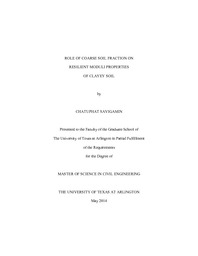
ATTENTION: The works hosted here are being migrated to a new repository that will consolidate resources, improve discoverability, and better show UTA's research impact on the global community. We will update authors as the migration progresses. Please see MavMatrix for more information.
Show simple item record
| dc.contributor.author | Savigamin, Chatuphat | en_US |
| dc.date.accessioned | 2014-07-14T20:26:37Z | |
| dc.date.available | 2014-07-14T20:26:37Z | |
| dc.date.issued | 2014-07-14 | |
| dc.date.submitted | January 2014 | en_US |
| dc.identifier.other | DISS-12702 | en_US |
| dc.identifier.uri | http://hdl.handle.net/10106/24433 | |
| dc.description.abstract | As one of the major methods of soil stabilization used in the present, mechanical stabilization improves a native soil by admixing a coarse and/or fine material. This method of soil stabilization aims to reach a composition in which coarser particles form the skeleton and the surrounding space is filled with fine grains. As a result, higher soil strength can be achieved. To study the soil strength improvement behavior, resilient modulus and unconfined compressive strength are used as evaluation parameters in this research. Since the present research focuses on subgrade soils, Dallas clay was selected as a reference clayey soil representing a native subgrade. Industrial silica sand was an admixing material. Six types of clay-sand mixtures were prepared from Dallas clay with 0%, 5%, 10%, 20%, 30%, and 50% sand admixture, respectively. Unconfined compression tests and resilient modulus tests were performed on six types of the clay-sand mixtures. The preparation of the test samples was adhered to their maximum dry density and optimum moisture content obtained from Proctor tests. The unconfined compression test results showed that unconfined compressive strength linearly increased with an increase in the sand admixture. For the resilient modulus (MR) tests, the measured MR results were analyzed with the universal model in order to determine the predicted MR results, which were found to be well matched with the measured results. Based on both measured and predicted MR results, the turning point of the clay-sand mixture from a stress-softening to stress hardening material was exhibited when the percentage of the sand admixture was increased to 10%. Both deviatoric stress and confining pressure are also found to have a significant effect on the resilient modulus. In addition, the resilient modulus (MR) improvement analysis showed that the MR significantly increased when the amount of the sand admixture was increased. The threshold of the effective resilient modulus improvement was also found at Dallas clay with 10% sand admixture. | en_US |
| dc.description.sponsorship | Puppala, Anand | en_US |
| dc.language.iso | en | en_US |
| dc.publisher | Civil & Environmental Engineering | en_US |
| dc.title | Role Of Coarse Soil Fraction On Resilient Moduli Properties Of Clayey Soil | en_US |
| dc.type | M.S. | en_US |
| dc.contributor.committeeChair | Puppala, Anand | en_US |
| dc.degree.department | Civil & Environmental Engineering | en_US |
| dc.degree.discipline | Civil & Environmental Engineering | en_US |
| dc.degree.grantor | University of Texas at Arlington | en_US |
| dc.degree.level | masters | en_US |
| dc.degree.name | M.S. | en_US |
Files in this item
- Name:
- Savigamin_uta_2502M_12702.pdf
- Size:
- 9.426Mb
- Format:
- PDF
This item appears in the following Collection(s)
Show simple item record


